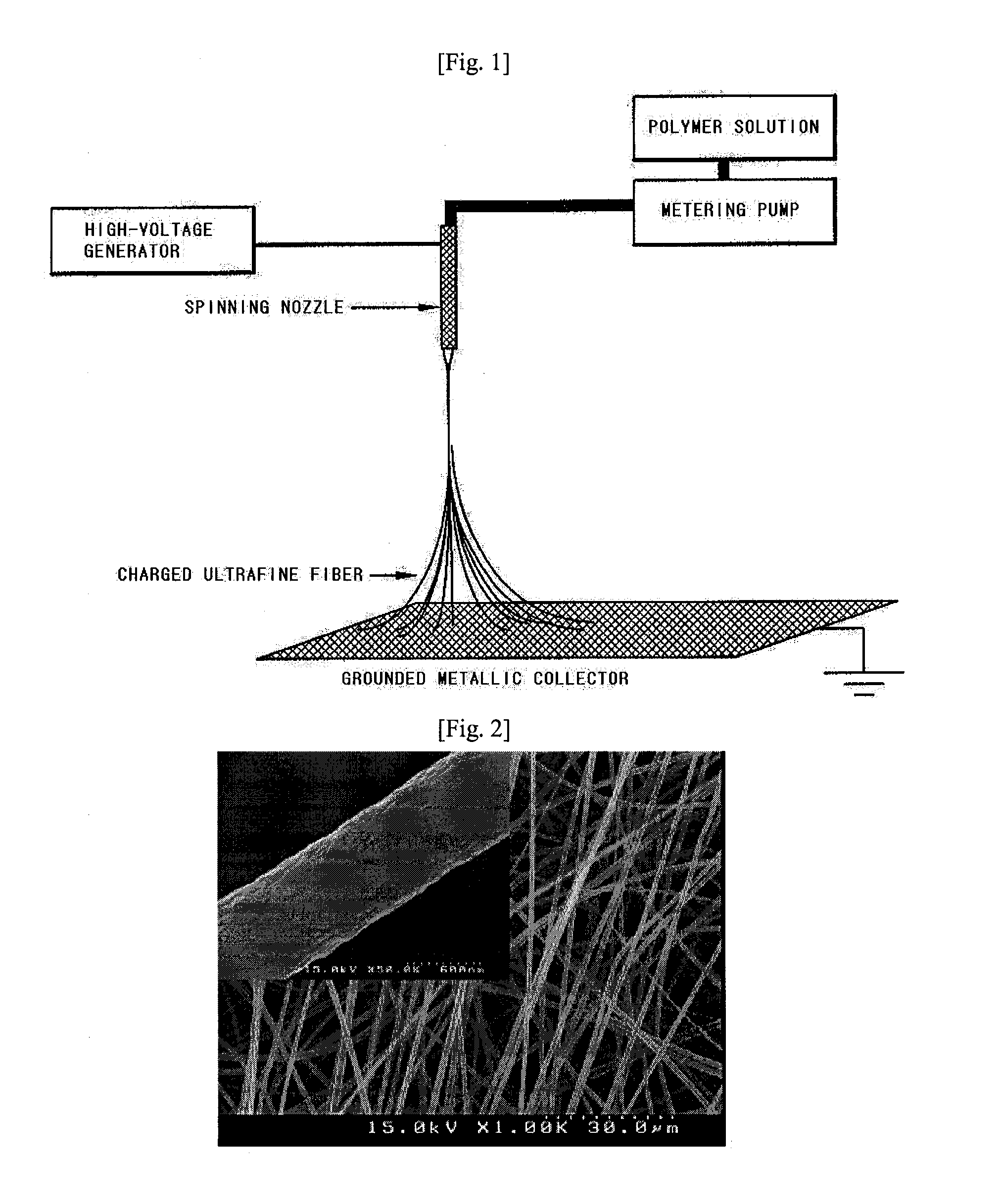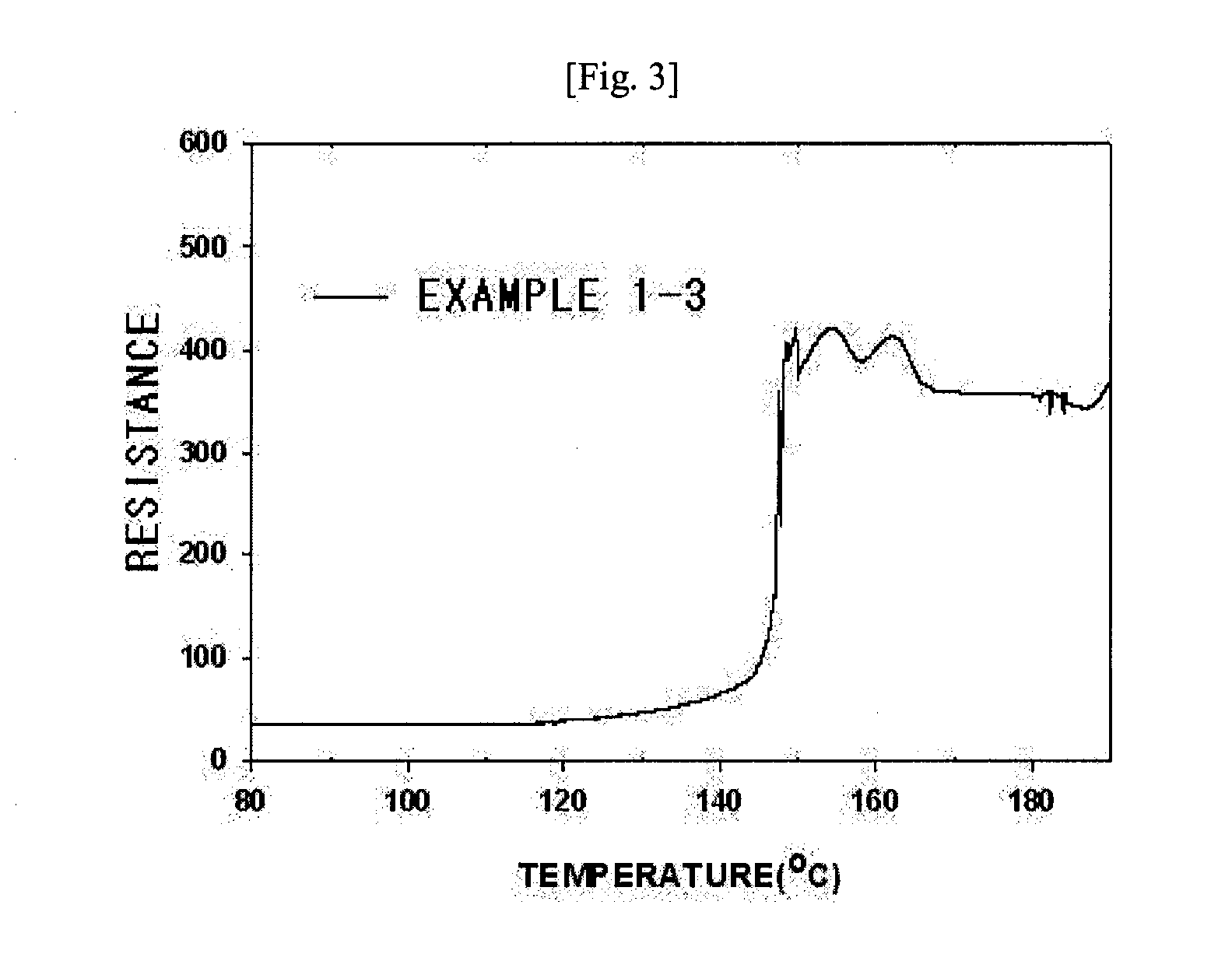Heat resisting separator having ultrafine fibrous layer and secondary battery having the same
a technology of heat resistance and separator, which is applied in the direction of secondary cell details, cell components, sustainable manufacturing/processing, etc., can solve the problems of short circuit, increase in battery weight, short circuit between anode and cathode, etc., and achieve excellent ionic conductivity, low thermal contraction characteristics, and thermal endurance
- Summary
- Abstract
- Description
- Claims
- Application Information
AI Technical Summary
Benefits of technology
Problems solved by technology
Method used
Image
Examples
example 1-1
[0056]In order to prepare heat-resistant polymer ultrafine fibers by electrospinning, 15 g of [poly(meta-phenylene isophthal amide), Aldrich] was added into 85 g of dimethylacetamide (DMAc), and then stirred at room temperature, thereby obtaining a heat-resistant polymer resin solution. The heat-resistant polymer resin solution was inputted to a barrel of electrospinning equipment as shown in FIG. 1, and then was discharged using a metering pump at a rate of 1000 / min. Herein, an electric charge of 17 kV was applied to the spinning nozzle using a high-voltage generator, so that a poly(meta-phenylene isophthal amide) ultrafine fibrous layer having a thickness of 10 μm was coated onto both surfaces of a polyethylene porous layer (Celgard 2730) having a thickness of 21 μm and a porosity of 43%, respectively. Herein, the coated amount was 2.5 g / m2.
[0057]The polyethylene porous film coated with the previously prepared poly(meta-phenylene isophthal amide) ultrafine fibrous layer was lamina...
example 1-2
[0058]In order to prepare heat-resistant polymer ultrafine fibers by electrospinning, 7.5 g of [poly(meta-phenyleneisophthal amide), Aldrich] and 7.5 g of poly(vinylidene fluoride-co-hexafluoropropylene) copolymer (Kynar 2801) were added into 85 g of dimethylacetamide (DMAc), and then stirred at room temperature, thereby obtaining a heat-resistant polymer mixed resin solution. Using the same method as in Example 1, the heat-resistant polymer mixed resin solution was coated onto both surfaces of a polyethylene porous film (Celgard 2730) so that a heat-resistant polymer ultrafine fibrous layer was compressed to be 5 μm in thickness, thereby preparing an integrated separator. Herein, the coated amount was 2.42 g / m2. Herein, the fibrous layer contained fibers having a fibrous shape of heat-resistant polymeric materials and a fibrous shape of swelling polymeric materials. The porosity of the ultrafine fibrous layer was 79%. The shrinkage rate at temperatures of 120° C. and 150° C. was 0....
example 1-3
[0059]It was the same as in Example 1-2 except that poly(vinylidene fluoride)(PVdF, Kynar 761) was used, instead of poly(vinylidene fluoride-co-hexafluoropropylene) copolymer (Kynar 2801). In this case, the coated amount was 2.7 g / m2. The porosity of the ultrafine fibrous layer was 84.2%. The shrinkage rate at temperatures of 120° C. and 150° C. was 0.2% and 1.8%, respectively. The uptake of the electrolyte solution was 300%.
PUM
| Property | Measurement | Unit |
|---|---|---|
| melting point | aaaaa | aaaaa |
| melting point | aaaaa | aaaaa |
| porosity | aaaaa | aaaaa |
Abstract
Description
Claims
Application Information
 Login to View More
Login to View More - R&D
- Intellectual Property
- Life Sciences
- Materials
- Tech Scout
- Unparalleled Data Quality
- Higher Quality Content
- 60% Fewer Hallucinations
Browse by: Latest US Patents, China's latest patents, Technical Efficacy Thesaurus, Application Domain, Technology Topic, Popular Technical Reports.
© 2025 PatSnap. All rights reserved.Legal|Privacy policy|Modern Slavery Act Transparency Statement|Sitemap|About US| Contact US: help@patsnap.com



